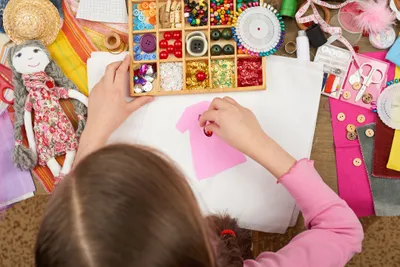Art is all around us—but sometimes we don’t stop to appreciate it because of our busy routines. At the same time, sometimes our creative outlets get put on the back burner, because there are always seems to be something of higher priority.
Whether immersing yourself in art or taking part in a creative activity, art can have many health benefits for the young and elderly (not to mention the possibility of creating something you can be proud of). Here are seven art benefits…
1. Art Helps Children Succeed Later in Life
According to RaisesSmartKid.com, participating in creative endeavors helps unlock potential in kids that can be applied when they’re older. It notes that researchers from Michigan State University “found a very strong correlation between childhood engagement in the creative arts and measurable success later in life.”
It goes on to explain that children who are immersed in arts and crafts are more likely of inventing things worthy of patents, or have a solid business start-up idea, or even publishing interesting papers in the field of science and technology. In short, kids who are encouraged to be creative think more outside the box, it adds.
2. Creativity Relieves Stress
BeBrainFit.com explains that many of the arts—whether it’s drawing, sculpting, painting or photography—are “relaxing and rewarding” hobbies that can help naturally calm you down and increase your mental clarity.
The act of producing art “provides a distraction, giving your brain a break from your usual thoughts,” notes the source. On that note, the source claims the average person has 60,000-thoughts per day and 95-percent of them are the same from day to day (so your brain could use a short vacation).
3. It Can Boost Immunity
Not only can art help make improvements in your mental state, it can actually help prevent illness, according to the Huffington Post. It points to a study published in the Journal of Psychosomatic Medicine that shows HIV patients who actively write has improved lymphocyte counts (healthier immune system).
The Journal of Psychosomatic Medicine study divided a group of subjects into two—one writing about “emotional” topics and the other “neutral” topics. It concludes the group that wrote emotionally (and presumably more creatively and personally engaged) had higher lymphocyte counts than the other group at measured intervals.
4. Art Helps Develop Emotional Intelligence
DrawingOnEarth.com explains that kids who have “complex” feelings that they’re having trouble expressing can do so more easily through art. This helps them “feel better about themselves and helps them understand others by ‘seeing’ what they have expressed and created,” it notes.
It also says art can help create more of a sense of purpose for kids, as well as eliciting a sense of joy about discovery—which can then be passed along to others.
5. The Art of Improving Memory
The popular networking site LinkedIn published an article about the health benefits of art, with one being improved memory. The example it uses it for knitting, which is a popular creative hobby these days. “The repetitive nature knitting and weaving are a great way to help improve memory. The brain creates the pathways for the pattern and the repetition makes the memory stronger,” it explains.
The author noted they started having lapses in their short-term memory (such as forgetting why they walked into a room or missing an appointment), so they stepped up the complexity of their knitting patterns and the memory lapses subsided after a few months.
6. It Can Help Patients with Mental Disorders
Art therapy (delivered by a qualified art therapist) is a technique that can benefit young and old, and it has the power to address some serious disorders and diseases, according to ArtTherapyBlog.com.
Not only can immersing patients in art help alleviate symptoms for those recovering from abuse, with post-traumatic stress disorder or bipolar disorder (it’s also commonly used to improve the morale of cancer patients), it can actually help reduce physical pain and tension, adds the blog.
7. Improving Fine Motor Skills
BrightHubEducation.com explains that art activities can help develop motor skills in children, which can aid in everything from buttoning a shirt, zipping up a jacket to writing a note by hand. “Children need opportunities to practice these, just as they would their spelling words or multiplication tables,” notes the site.
Luckily, the source has a number of suggestions for art-focused learning in a classroom setting, from tracing pictures or drawing dot-to-dot, creating clay sculptures, stringing beads onto a necklace, and much more that can also be applied at home.










